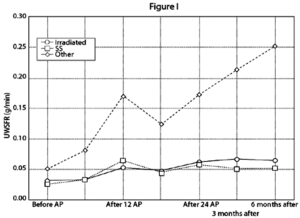Xerostomia, more commonly known as dry mouth, is a clinical condition that can lead to a decrease in (or in some cases, a complete lack of) the production of saliva.
The most common forms of combating dry mouth are the use of saliva substitutes and stimulation of the salivary glands by sucking lozenges or chewing gum. These therapies have several disadvantages, however, in that they must be used constantly, and that their effects are often short-lived.
Although acupuncture has been discussed in the United States as an alternative therapy for dry mouth for nearly two decades, few large-scale studies have been conducted, and even fewer have been conducted on cancer patients. In one of the largest studies to date, a pair of researchers from Sweden tested the long-term efficacy of acupuncture on 70 patients with dry mouth and found that treatment resulted in "significant improvement" in saliva production for up to six months, with additional treatments maintaining this improvement up to three years.
Drs. Maria Blom and Thomas Lundeberg conducted the study, which was published in the journal Oral Diseases. In addition to cancer patients, Blom and Lundeberg measured the effects of acupuncture on groups of patients with Sj˜gren's syndrome (a systemic disease that causes dry mouth) and other conditions such as menopause and depression. Every patient received an initial course of 24 acupuncture treatments, with individual treatments given twice a week over a four-month period. After the first course of treatment, the patients were observed for a minimum of six months, then offered additional acupuncture treatments as needed.
All acupuncture treatments were performed by Dr. Blom, a certified acupuncture practitioner with more than 14 years of experience. Acupuncture points in the head, hands and legs were stimulated, including: ST3; ST5; ST6; ST7; SI17; LI18; TE17; GV20; H7; P6; LI3; LI4; LI11; TE5; ST36; SP6; GB41; LR3; K3; and K5. Other points were used if the patients complained of nausea, stress or other conditions.
In general, the needles were inserted bilaterally; additional needles were used in patients who had other disease or complaints. Needles were inserted manually until de qi was obtained, at which time they would be left in place for 20 minutes.
Patients were tested objectively by measuring their salivary flow rate (SFR) before and after every additional course of treatment, and on as close to an annual basis as possible for three years. Both stimulated (by chewing paraffin) and unstimulated saliva flow were measured using strict protocols to avoid any variation among subjects. Patients who chose not to have additional acupuncture treatments were also checked on a yearly basis to measure saliva flow.

Figures I (above) and II (below): Mean unstimulated and stimulated salivary flow rates in patients grouped by condition. SS = Sjogren's syndrome; AP = acupuncture treatment.

Results of the study showed that acupuncture treatment appeared to produce an increased flow of both stimulated and unstimulated saliva. Sample tests showed that all three groups of patients had "significantly higher salivary flow rates" in unstimulated saliva after 12 and 24 acupuncture treatments, with the greatest increase being reported in the group of irradiated cancer patients. These increased saliva rates continued well after the last acupuncture treatment had been delivered.
Stimulated saliva rates were also "significantly higher" for each group after receiving acupuncture, with the greatest increases occurring after receiving between six and 12 treatments. These increases were still seen as much as six months after treatment.
Additional acupuncture care also appeared to benefit patients for several years after their initial course of treatment. Long-term observation revealed that "patients who chose additional treatment had consistently higher median SFR than patients who chose not to continue acupuncture treatment" and that "the median SFRs were consistently higher at each time point up to three years" for both stimulated and unstimulated saliva flow.
While Lundeberg and Blom were unable to determine exactly how acupuncture led to an increase in saliva secretion, they theorized that needle stimulation may lead to the release of neuropeptides, substances that act as signals to control a variety of bodily functions, including blood flow and the production of saliva. Neuropeptides are also known to affect the autonomic and sympathetic nervous systems, which are both involved in the salivation process.
Given the possible symptoms it may cause, it is quite clear that xerostomia can have a negative impact on one's quality of life. It is also quite clear, based on the Blom and Lundeberg study, that acupuncture can help relieve these symptoms, and that it can do so for a much longer duration (and with less frequent treatment) than most of the conventional therapies currently available. As the researchers state in their conclusion:
"This study shows that 24 acupuncture treatments result in statistically significant improvement in SFR in patients with xerostomia in the long-term up to six months. It suggests that additional appropriate acupuncture treatment can maintain this improvement in SFR up to three years."
Reference
- Blom M, Lundeberg T. Long-term follow-up of patients treated with acupuncture for xerostomia and the influence of additional treatment. Oral Diseases 2000;6(1):15-24.



